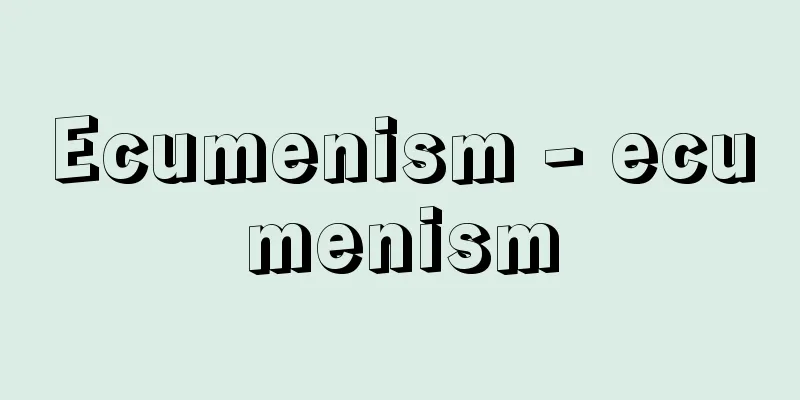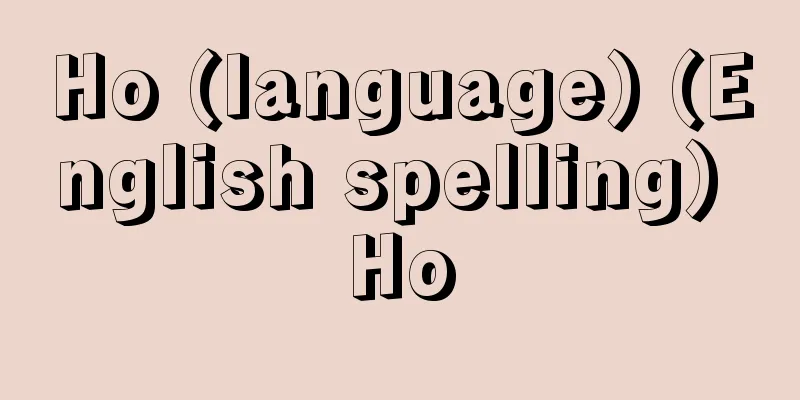Ecumenism - ecumenism

|
The spirit of reuniting all the divided Christian churches. The ecumenical movement that aims to achieve this is called the ecumenical movement (Catholic) or the ecumenical movement (Protestant). Historically, since the separation of the Roman Catholic Church and the Eastern Orthodox Church in 1054, attempts at unification were made through the Councils of Lyon (1274) and Florence (1439), but these only had a very temporary effect. In the second half of the 17th century, German Protestants, represented by Leibniz, called for church unity, but this was completely unsuccessful. After that, there were no notable movements, and it was not until the 19th century that the idea of unification began to be considered, but it was not until the 20th century that this became a full-fledged movement. Between the Catholic Church and the Church of England, the Mechelen Conference (1921-1925) was held under the leadership of Cardinal Désiré Joseph Mercier (1851-1926) and Lord E. Wood Halifax (1881-1959), while the Church of England sought to achieve a union with the Eastern Orthodox Church (1906) and also attempted to approach them at the Fifth Lambeth Conference (1908).In the Catholic Church, Pope Leo XIII preached the need for unity of faith in his encyclical "To the Princes and Peoples of the World" in 1894, but it can be said that the truly modern movement for ecumenical unity was born from within the Protestant churches, which aimed to solve problems in overseas missions and to be effective in spreading the gospel. In 1910, the World Missionary Congress was held in Edinburgh, where it was decided to take the first step towards unity in theological and ecclesial dimensions through the "Faith and Order" movement, and in 1925, the "Life and Practice" movement was launched, calling for unity in practical aspects of social and economic life. In 1937, conferences held in Oxford and Edinburgh decided to combine these two major movements and establish the World Council of Churches (WCC for short). This decision was postponed due to the Second World War, and it was not until the Amsterdam Conference in 1948 that it was officially launched. It still functions as the highest authority of the world church movement today. On the other hand, the Catholic Church also made concrete efforts toward church unity in the 20th century. The Week of Prayer for Unity, which was started by the Anglican Reverend Paul Watson in 1908, was also implemented in the Catholic Church the following year when he converted. In 1925, Bouduin Lambert (1873-1960) founded a priory in Amey (later Cheboutigny) in Belgium and began publishing the magazine Irenikon the following year. Yves M. J. Congar (1904-1995) launched the Unam Sanctus series, which aimed to pursue church unity. Paul I. Couturier (1881-1953) created the "Week of Prayer for All," an eight-day event that prayed for "the unity that God desires in the way that God desires." Furthermore, in 1952, the Catholic Council on the Question of Ecumenical Unity was established as a liaison organization with the research department of the World Council of Churches. Under these circumstances, it was the Second Vatican Council (1962-1965) and its convener, Pope John XXIII, who truly led the Catholic Church into the ecumenical movement. Advocating a shift from "Singleton" to "Dialogue," he restored relations with Patriarch Athenagoras I of Constantinople and requested that non-Catholic Christian churches be sent as observers to the Council. In 1960, he established the Secretariat for Promoting Christian Unity within the Holy See, and sent an official representative to the third WCC held in New Delhi the following year. Pope John XXIII's document on Ecumenical Unity, "Unitatis Redentegratio," was adopted and promulgated at the Council in 1964. The Catholic Church then completely abandoned its stance of making church unity a condition for "return to the Church of Rome." The next Pope, Paul VI, met with Arthur Michael Ramsey (1904-1988) of the Church of England in Rome (1966) and visited Patriarch Athenagoras in Turkey, further developing the movement for unity. Of particular note was the lifting of the mutual excommunication between Rome and Constantinople in 1054 on December 7, 1965. Furthermore, Paul VI made an official visit to the WCC headquarters in Geneva in 1969 and expressed his intention to cooperate with Protestant churches in the ecumenical movement. In the United States, the Institute for Ecumenical Culture was established at St. John's University in Collegeville, Minnesota in 1968. Currently, churches agree on the basic principle that "the body of Christ must be one." However, due to historical circumstances and the circumstances of each church, it must be said that the establishment of a complete world church is still a long way off. However, it is true that the spirit of ecumenism is steadily taking root as a realistic movement. At the same time, there have been many voices calling for the "crisis of ecumenism," fearing that the movement will become officially institutionalized and take on a bureaucratic nature. However, the movement for ecumenical unity, which is organized by the WCC and the Holy See, does not seek to forcibly unite various denominations and churches, nor does it create a church federation that will form a convenient united front to deal with an immediate emergency. It is for each church, which has a different historical background and conditions, to deepen mutual understanding based on respect and love, acknowledge each other's existence, realize that they are part of the world church, and become united in Christ. Specifically, it began with the rapprochement of Catholicism and the Church of England, which share common doctrine and liturgy, and has progressed to include all Protestant churches. Although not directly related to this movement, the "dialogue with other religions" that was taken up in the Council can be seen as further expanding its scope (when social problems occur in Japan, such as the Great East Japan Earthquake, all Christian churches, Buddhists, and Shintoists jointly held memorial and relief meetings). The sole and ultimate goal of this movement is for all churches to come together to confront all the problems facing the modern world, to preach the gospel in order to make amends for them, to preach love for humanity, and to contribute to world peace based on faith in God. [Isomi Tatsunori] "History of Christianity 11" by Hayar et al., edited, translated and supervised by the Institute of Medieval Thought, Sophia University (1991, Kodansha) [References] | | | | |Source: Shogakukan Encyclopedia Nipponica About Encyclopedia Nipponica Information | Legend |
|
分裂した全キリスト教会をふたたび一致させようという精神。この実現を目ざす運動ecumenical movementを「教会一致運動」(カトリック)あるいは「世界教会運動」(プロテスタント)とよぶ。歴史的には、1054年のローマ・カトリック教会と東方正教会との分離以来、リヨン(1274)、フィレンツェ(1439)の公会議を通じて統一への試みがなされたが、それらはきわめて一時的な効果しかなかった。17世紀後半には、ライプニッツを代表とするドイツ・プロテスタントからの教会合同のよびかけがあったが、これはまったく実らなかった。その後特筆すべき運動もなく、19世紀に入ってようやく統一への理念が検討されるようになるが、これが運動として本格化するのは20世紀に入ってからである。カトリックと英国国教会(イングランド教会)との間では、マリーヌ(メヘレン)会談(1921~1925)がメルシェ枢機卿(すうききょう)Désiré Joseph Mercier(1851―1926)とハリファックス卿Lord E. Wood Halifax(1881―1959)とを指導者として開催され、一方、英国国教会は、東方正教会との連盟(ユニオン)(1906)の実現を図り、また第5回ランベス会議(1908)などでこれに接近を試みた。カトリック教会でも教皇レオ13世が、1894年に回勅「全世界の君主と国民に」によって信仰一致の必要を説いたが、真に現代的な教会一致運動は、海外宣教上の諸問題の解決と福音(ふくいん)伝道上の効果とを目ざすプロテスタント教会のなかから生まれたといえる。1910年エジンバラで世界宣教会議が開催され、「信仰と職制」運動を通じて神学的教会的次元における一致への第一歩を踏み出すことが決定され、さらに1925年には「生活と実践」運動が発足し、社会的、経済的生活上の実践面における一致への要請がなされた。1937年オックスフォードおよびエジンバラで開かれた会議は、この二大運動を合体させた世界教会協議会World Council of Churches(略してWCC)の設立を決定した。この決定は、第二次世界大戦のため実現が延期され、1948年のアムステルダム会議によって正式の発足をみるに至った。これは、現在なお世界教会運動の最高機関として活動している。 一方、カトリック教会においても、20世紀に入ると、教会一致への具体的な努力がみられる。英国国教会のポール・ワトソン師が1908年に始めた信仰一致祈祷(きとう)週間は、翌年彼の回宗とともにカトリックでも実施され、1925年にはボーデュアン師Bouduin Lambert(1873―1960)がベルギーのアメー(のちにシュブトーニュ)の小修道院を創設し、翌年より『イレニコン』誌の刊行を行い、コンガール師Yves. M. J. Congar(1904―1995)は教会一致の追求を目標とした『唯一の聖なる(ウナム・サンクトゥス)』叢書(そうしょ)を創刊した。クテュリエ師Paul I. Couturier(1881―1953)は「神が望む方法によって神が望む一致」を願う8日間の「万人の祈祷週間」を実現した。さらに1952年には、世界教会会議の研究部門との接触機関として「教会一致問題カトリック会議」が発足した。こうした状況下にあって、真にカトリック教会をエキュメニズム運動に導いたのは、第二バチカン公会議(1962~1965)であり、その招集者たる教皇ヨハネス23世であった。「独語」から「対話」へを標榜(ひょうぼう)する彼は、コンスタンティノープル総大主教アテナゴラス1世との間に関係を復活し、公会議に非カトリック・キリスト教教会からのオブザーバー派遣を要請し、1960年には教皇庁内にキリスト教徒一致推進事務局を設け、翌年開かれたニュー・デリーにおける第3回WCCに公式代表を送った。ヨハネス23世の教会一致に関する教書「ウニターティス・レディンテグラーティオ」は、1964年公会議において採択され、公布された。ここに教会一致を「ローマ教会への復帰」を条件に実現させようとする姿勢を、カトリック教会は完全に放棄したのである。次の教皇パウルス6世は、ローマにおいて英国国教会のラムゼー博士Arthur Michael Ramsey(1904―1988)と会談し(1966)、さらにトルコにアテナゴラス総大主教を訪問し、一致運動をさらに発展させた。とくに注目すべきことは、1965年12月7日、1054年にローマとコンスタンティノープルとの間で行われた相互破門の解除が宣言されたことである。さらに、パウルス6世は1969年、ジュネーブのWCC本部を公式訪問し、エキュメニズム運動におけるプロテスタント教会との協力の意志を表明した。アメリカでは、1968年にミネソタ州カレッジビルのセント・ジョンズ大学にエキュメニズム文化研究所が設けられている。 現在、各教会は、「キリストの体は一つでなければならない」という基本的理念においては一致している。だが歴史的経緯やそれぞれの教会の事情により、完全な世界教会の成立は遠いといわざるをえない。しかし、エキュメニズムの精神が、確実に現実的な運動として定着化しつつあることは事実である。その一方で、この運動が公的に制度化し、官僚機構的な体質を帯びることを危惧して「エキュメズムの危機」を訴える声も少なからず聞かれた。 しかし、WCCや教皇庁を機関とする教会一致運動は、諸教派、諸教会を強制的に合体させようとするものではなく、また目前の緊急事態に処するために便宜的な共同戦線を張るような教会連盟をつくるものでもない。それは、異なった歴史的な背景と条件のもとにある各教会が、それぞれ尊敬と愛に基づく相互理解を深め、その存在を認めあったうえで、世界教会の一員であることを自覚し、キリストのうちに一致することである。具体的には教義、典礼面で共通性のあるカトリックと英国国教会の接近に始まり、全プロテスタント教会を加えた運動に進展している。なお、直接この運動に関係しないが、公会議のなかで取り上げられた「他宗教との対話」がさらにその範囲を広げているとみることもできよう(日本でも社会的問題がおこったとき、たとえば東日本大震災に対し、全キリスト教会と仏教、神道の信者が合同で慰霊、救済の会を催している)。この運動は全教会がともに現代世界が抱えるあらゆる問題と対決し、その償いのために福音を宣揚し、人類愛を説いて神への信仰に基づく世界平和に寄与することを唯一また究極の目的とするのである。 [磯見辰典] 『ハヤールほか著、上智大学中世思想研究所編訳・監修『キリスト教史11』(1991・講談社)』 [参照項目] | | | | |出典 小学館 日本大百科全書(ニッポニカ)日本大百科全書(ニッポニカ)について 情報 | 凡例 |
Recommend
Chidori's song - Chidori no kyoku
The title of a koto piece. A work from the late E...
Seseli ugoensis Koidz.
A perennial herb of the Umbelliferae family that g...
Dal'nevostochnyi ekonomicheskii raion (English notation)Dalnevostochnyiekonomicheskiiraion
...is often not included in the Siberian region. ...
Nogawa River
A river that flows west through the Shimajiri area...
Komau-ji
A clan of immigrants from royal families of Gogury...
Emperor Gohorikawa
An emperor in the early Kamakura period (reigned ...
Krasnyi internatsional profsoyuzov (English transcription) Krasnyi internatsional profsoyuzov
…the abbreviation for the Red Trade Union Interna...
false fruit
...Some species, such as the Tessen and the Acant...
Chuta Ito
Architect and architectural historian. Born in Yo...
Peter Behrens
German architect. Born in Hamburg. Initially he a...
namaz (English spelling)
… [Ritual] The Twelver, the major Shiite sect, sh...
Dominion - Jichiryo (English spelling)
Originally, it was a name given to the powerful co...
Lapageria
…A climbing shrub of the lily family native to Ch...
Riverbed
The bed of a river that is covered with water. It ...
lava fountain
…Many of Japan's volcanoes erupt explosively,...









